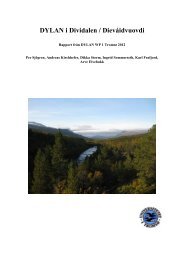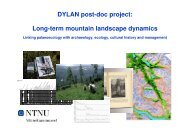Guide to identification of Lumbrineridae (Polychaeta) - NTNU
Guide to identification of Lumbrineridae (Polychaeta) - NTNU
Guide to identification of Lumbrineridae (Polychaeta) - NTNU
You also want an ePaper? Increase the reach of your titles
YUMPU automatically turns print PDFs into web optimized ePapers that Google loves.
<strong>Lumbrineridae</strong> in Norwegian and adjacent waters 20<br />
Species <strong>of</strong> uncertain status<br />
Lumbrineris minuta (Théel, 1879).<br />
The species was described from Novaya Zemlya. The original description is comprehensive and well<br />
illustrated (Théel 1879), but apparently mixes characters from several species. Oug (1998) examined<br />
parts <strong>of</strong> the original material and confirmed that it consists <strong>of</strong> two or more species. In faunal surveys<br />
the species name appears <strong>to</strong> have been used for several small species from Arctic waters belonging in<br />
Abyssoninoe, Scole<strong>to</strong>ma and Lumbrineris. Oug (1998) concluded that the species is indeterminate and<br />
needs <strong>to</strong> be re-examined <strong>to</strong> assess its status.<br />
Lumbrineris labr<strong>of</strong>imbriata (Saint-Joseph, 1888)<br />
The species was described from Brittany, France. Comments <strong>to</strong> the species and description <strong>of</strong><br />
characters have been given by Laubier (1959) and Ramos (1976). The main characteristics are a<br />
denticulate inner margin <strong>of</strong> the mandibles and presence <strong>of</strong> both composite and simple hooded hooks in<br />
anterior chaetigers. Carrera-Parra (2006b), however, noted that these features occur during on<strong>to</strong>genetic<br />
development in Lumbrineris and considered the species as invalid.<br />
Lumbrineris cluthensis (Clark, 1953)<br />
The species was described from Firth <strong>of</strong> Clyde, west coast <strong>of</strong> Scotland. Several specimens have later<br />
been found in British coastal waters (O’Reilly & Mackie, pers. commn). It is characterised by having<br />
blunt spine-like hooks and limbate chaetae in all chaetigers. Hooded hooks are absent. The maxillary<br />
apparatus is supported by two pairs <strong>of</strong> carriers, <strong>of</strong> which the posterior is the largest (Clark 1953,<br />
George & Hartmann-Schröder 1985). The species does not conform <strong>to</strong> the description <strong>of</strong> the<br />
<strong>Lumbrineridae</strong> due <strong>to</strong> its lack <strong>of</strong> hooded hooks and is possibly more closely affiliated <strong>to</strong> Oenonidae.<br />
Acknowledgements<br />
Figs from left: Anterior end;<br />
mandibles; maxillae; parapodium 1;<br />
parapodium 85; chaetae. From Clark<br />
(1953)<br />
The present guide has been developed during several decades <strong>of</strong> study <strong>of</strong> polychaetes in North East<br />
Atlantic and Arctic waters during environmental moni<strong>to</strong>ring in coastal and <strong>of</strong>fshore areas, and<br />
taxonomic studies <strong>of</strong> the group Eunicida (projects BIOFAR, BIOICE, COBICE, Swedish Kattegat<br />
surveys). The guide is based on a previous version prepared for the British NMBAQC benthic<br />
taxonomic workshop 2003 and has been developed in conjunction with an update <strong>of</strong> the NMBAQC<br />
guide. The work has received financial support by the Norwegian Academy <strong>of</strong> Science and Letters<br />
(DNVA) through the Norwegian Deepwater Programme (NDP) for taxonomic studies <strong>of</strong> <strong>Polychaeta</strong> in<br />
deep areas <strong>of</strong> the Norwegian Sea, and by Eni Norge and Eni E&P, through the Arctic Seas<br />
Biodiversity (ASBD) Project (www.arcticbiodiversity.com; WP4-1.4). I am grateful <strong>to</strong> several users <strong>of</strong><br />
previous guide versions for comments and suggestions <strong>to</strong> improvements. Nataliya Budaeva, Shirshov<br />
Institute <strong>of</strong> Oceanology, Moscow, provided translations <strong>of</strong> Russian literature.





